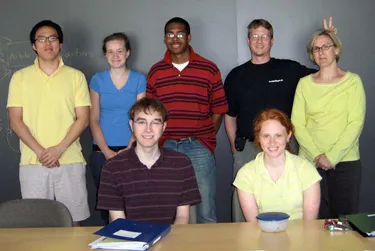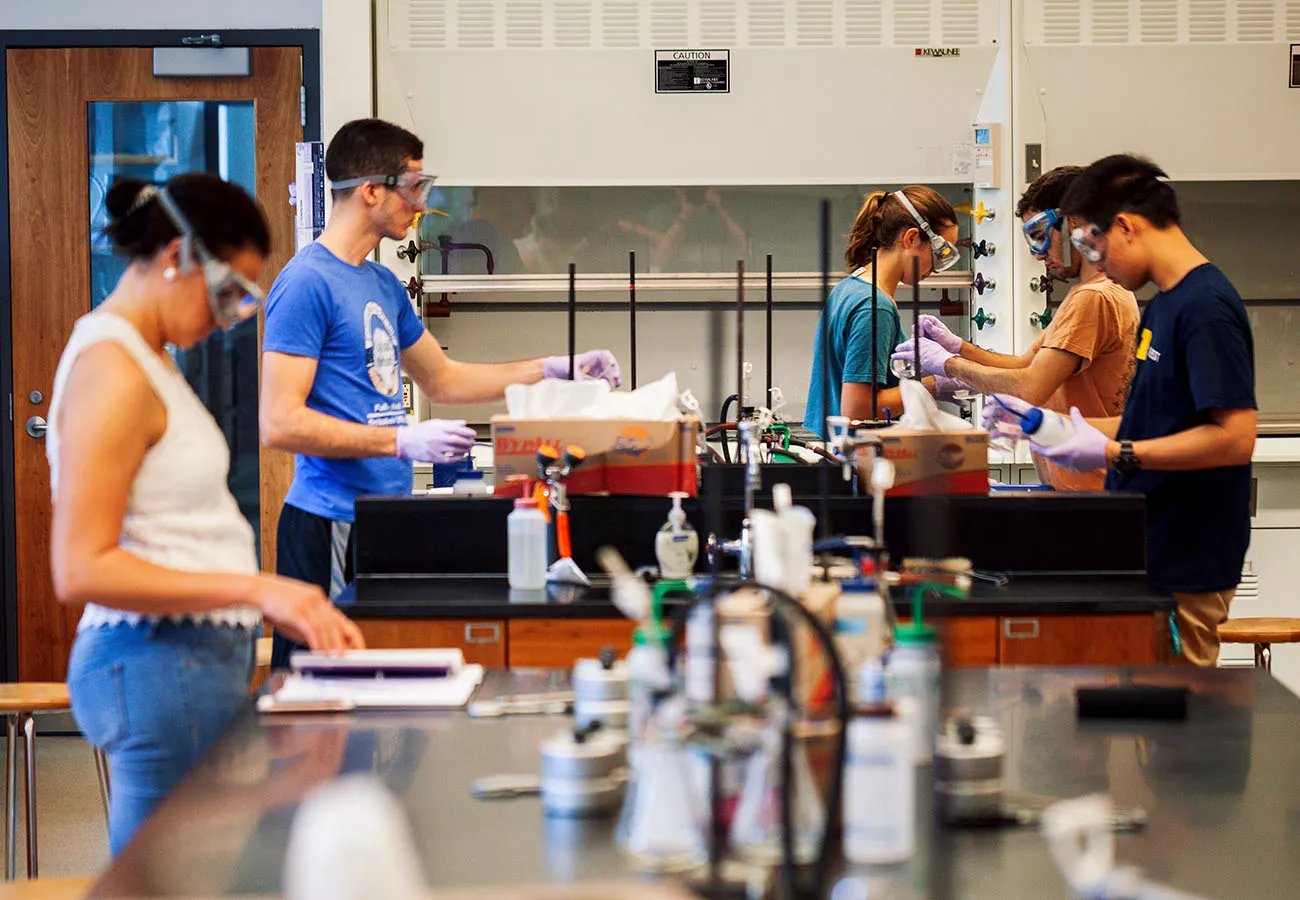Amy Cheng Vollmer: Research

1. Expression of the lux operon is driven by a stress responsive promoter. Light produced -proportionate to the level of transcription- is quantifiable over 7 orders of magnitude in real time. 2. Bioluminescent E. coli, expressing the lux genes from Vibrio fischeri.
Amy Cheng Vollmer | Courses | Research | Professional Activities
Abstracts | Publications | Professors in the Vollmer Lab
Mine is the only lab in the department that studies bacteria. The focus of our investigations is bacterial stress response. Our investigations include hypotheses and methods in genetics, physiology, biochemistry as well as in ecology and evolution. Bacterial stress response is an area of expanding interest because it spans problems in infectious disease, environmental remediation, ecological consortia, biofilm establishment and long term evolutionary selection. Since 1994, our laboratory has participated in and contributed to the Gordon Research Conference on Microbial Stress Response. We also present posters at the General Meeting of the American Society for Microbiology in the Division I (General Microbiology) sessions on Microbial Stress Response.
Escherichia coli is the model system of choice. It is the best characterized member of the prokaryotes, with a rich historic tradition as well as much current investigation. This model system has provided paradigms for study in molecular genetics, bioenergetics, enzymology and bioinformatics. There is a vast international network of scientists who contribute to this field. In particular, response to stress involves: the sensing of stress (external or internal to the cell); the transduction of the stress signal to regulators inside the cell; the induction of transcription of genes whose products serve to reduce the stress; restoration of a steady state balance in the cell; frequent cell-cell communication to coordinate a multicellular response; individual stochastic variation upon which natural selection operates
Many stress response pathways are well-conserved through the phyla, indicating an ancient evolutionary advantage for those organisms that were able to sense and respond to stress in a timely and strategic manner. It should not be surprising that the mechanisms that all cells use to respond to stresses like heat shock, oxidative stress and DNA damage would be very homologous. On the other hand, stresses that are more environmentally unique, like certain macro- or micro-nutrient limitations, have a more customized mechanism that suits a particular niche and organism.
A fundamental question that we are pursuing is how bacterial cells regulate the expression of a specific subset of stress response genes. Our laboratory uses a bioluminescent reporter: this allows us to measure the induction of transcription of a particular gene, by fusing a copy of the promoter of that gene to a group of lux genes. The lux genes encode enzymes that work in a cycle and produce light as a by product of the chemical reactions. This light can be quantified (linearly over 7 orders of magnitude) and in real time (so cells do not have to be broken open to measure the light).
A panel of bioluminescent stress-responsive E. coli strains were developed in collaboration with Robert LaRossa, Tina van Dyk and Shimshon Belkin while we were together at DuPont in the mid 1990s. Since then, our laboratory has continued to construct new 'reporter' strains as well as to use those original strains in various environmental applications. Some of the questions addressed in those studies were:
Can stress responsive bacteria be used to measure antioxidant activity found in green tea?
Can strains that respond to ammonia and phosphate limitation be used to measure the concentrations of those nutrients in the waters of the Chesapeake?
Does high frequency ultrasound kill bacteria? And if, so, by what mechanisms?
Can ultrasound be used to sterile apple cider effectively?
Co optical tweezers induce oxidative stress or heat shock as cells are captured in the laser?
The ultrasound studies were conducted in collaboration with a colleague, Carr Everbach, in our Engineering Department. The optical tweezers study was a conducted by a student who was jointly mentored by myself and a former member of the Department of Physics and Astronomy.
Another area of study in the laboratory has been on the role of Universal Stress Proteins in the regulation of stress response in E. coli. These investigations have included the testing of various bioluminescent reporters in E. coli that are lacking the uspA, uspC and/or uspE genes. In addition, we have studied biofilm formation and the influence that usp genes might have on adherence to plastic.
Previous undergraduate studentsin the laboratory, and their post-Swarthmore trajectory(If you want to update yours, contact me!)
Over the past 20+ years, I have hosted dozens of students in my laboratory and have stayed in touch with many of them. To see where they have gone, click on my CV.
These students conducted summer research projects in my laboratory and often initiated and usually extended the projects in the academic year. An additional 20 students spent one or two semesters in the laboratory, but took advantage of summer research experiences elsewhere. Many students who do research in my laboratory have the opportunity to present their research at conferences and meetings. The most prestigious meeting is the General Meeting of the American Society for Microbiology (ASM). Poster abstracts for that meeting undergo a rigorous peer-review before acceptance.
Some of the students who have conducted summer research in my laboratory (and 2 students who were supervised by a visiting microbiology faculty member) have secured funding in the form of an Undergraduate Research Fellowship (URF) from the ASM. Those fellows had a summer stipend, a year of student membership and travel to the ASM meeting paid by the ASM. Their fellowships were awarded based on an application that included a personal statement, research proposal and letters from faculty members. Competition for these fellowship is intense at the national level.
Previous ASM URFs from Swarthmore: Nina Kogekar '13, Natasha Weiser '10, Sunjay Barton '09, Nanelle Barash '08, Meagan Bolles '06; Charlie Buffie '06; Aparna Kishor '05; Jeanne McFalls, '03; Mathew So '03; Andrew Alderete '02; Cristina Cardemil '01; Clarissa Nobile '01; Nathaniel Hanson '99 - supervised by visiting faculty member, Anna Tischler '99 - supervised by visiting faculty member; Marianna Ruzinova '98; Matthew Halpern '98; Elizabeth Glater '97; Adisetyantari Suprapto '96
Dr. Vollmer hosted 2 more colleagues in her laboratory during the summer of 2007:

Standing (l to r): Dan Yoon '08, Katie Condon '08, Cory Benjamin '10, Dr. Bruce Maxwell (Department of Engineering), Dr. Barbara Milewski (Department of Music & Dance) seated (l to r): Ben Krasity '08, Nell Barash '08
The Vollmer lab has also hosted many non-science Swarthmore faculty over the years.




